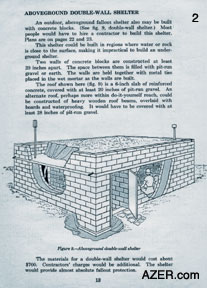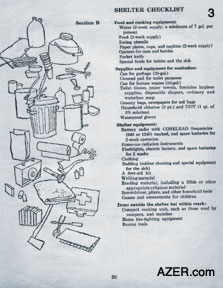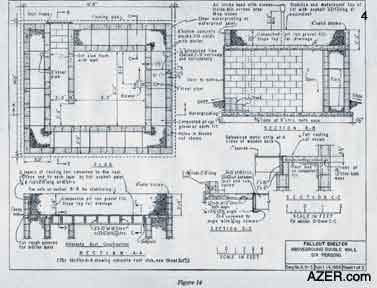|
2. Sketch
and description of what the Fallout shelter might look like from
outside. Note that it was generally covered with earth when finished.
Above: 3. This Shelter Checklist recommended stocking up a two-weeks' supply of food and water - a minimum of 7 gallons for each person. In addition, they suggested battery radio, flaslights, spare batteries, lamp, bedding, clothing, First-Aid kit, and reading material, including a Bible. 4. Actual plans to build the Family Fallout Shelter, which had exterior walls about 14x16.5 feet with about 10 sq ft internal space for living. They recommended that in an emergency not more than six people crowd this small space. Actually, the Family Fallout Shelter was designed to protect us from nuclear fallout, not from a nuclear strike. I remember that once it was built, I felt a certain calmness in knowing that we had taken some steps to counter the threats that we thought existed. Looking back, I have my doubts about how much protection the shelter really could have provided. The booklet reads: "The entrance must have at least one right-angle turn. Radiation scatters somewhat like light. Some will go around a corner. The rest continues in a straight line. Therefore sharp turns in a shelter entrance will reduce radiation intensity inside the shelter. Ventilation is provided in a concrete block basement shelter by vents in the wall and by the open entrance." The shelter was built underground with outer walls 16.5 ft by 14 ft, which made its inner cell dimensions not much wider than 10 x 10. The hole in the ground was dug with an excavator known as a backhoe. The whole structure cost around $400. The shelter dumped more chores on me. It was my duty to empty the dehumidifier once or twice a week, and I was responsible for rotating the stored water - they recommended seven gallons per person for two weeks. There were three of us - Mom, Dad and me. Those tasks ended when I went to college. The shelter also gave my father an excuse to buy our first AM/FM transistor radio. You may not know this, but your father had made a private agreement with my Dad that, in the event of an emergency, your family would join us in the shelter as well. It turns out that Dad had made similar promises to two other families on the street, which would have brought together about 20 people in that tiny space of one room. The government had recommended that such a shelter could hold maximum six people comfortably. Dad always used to say that if we ever had an emergency that lasted a long time, we would all have to sleep standing up! It's rather comical to look back on these plans now; but at the time, building a Family Fallout Shelter was considered conventional wisdom. A parallel might be the cautionary advice that is being recommended for pandemic bird flu these days. If disaster strikes, the advice will be considered wise and poignant. If it doesn't, 50 years from now people will snicker at such naiveté. It's strange how descriptions can alter perception. Instead of calling it a "Family Fallout Shelter", if we had called it a "Storm Shelter" or a "Fruit Cellar," I'm sure it would have left us with different impressions of that Cold War era. The truth is: there were so many National Civil Defense Centers scattered around the country. Usually they were located in the basement of small town post offices and were stocked with all sorts of canned water and goods. The supplies mostly all went to ruin. These days, you can run across some such remnants of those days at Army surplus stores. When I think back to childhood and the memories associated with that shelter, I can only wish that my family had such a sanctuary today. It was a great place to store fruit and vegetables and a wonderful refuge in which to hide when storms came. Out here in Wild West Montana where I live now, personal preparedness is highly regarded. Everyone out here stockpiles food and water as the winter blizzards can halt all commerce and transportation. We even carry a tent and sleeping bags in the car during winter, as a whiteout can strand you, even in the city. At any rate, thanks for the memories. I think that Azerbaijan International should build a Family Fallout Shelter and house all the magazine archives in it! _____ Back
to the article
(Autumn 2006) |




